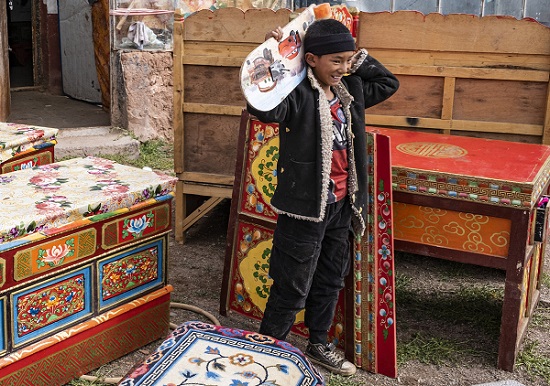Tibet aims to enhance livelihood in 2023, report to regional people's congress says

A boy carries his skateboard at a village in Shuanghu county, Tibet autonomous region, to prepare for his move to a new home, July 13, 2022. This is part of the region's efforts to relocate high-altitude herdsmen in Shuanghu county, Nagqu, to new homes by the Yarlung Zangbo River to protect the environment. [Photo/Xinhua]
The Tibet autonomous region expects to continue to improve people's quality of life in 2023, said Yan Jinhai, chairman of the regional government, on Friday.
In 2023, the region expects to see GDP growth of 8 percent, as well as 8 percent per capita growth in disposable income for urban residents and 10 percent for rural residents, Yan said, while the consumer price index will be kept below 3 percent, and urban unemployment below 5 percent.
Yan announced the targets while delivering the government work report at the annual session of the regional People's Congress, which opened on Friday.
"The year 2022 was an essential and extremely extraordinary year. The 20th National Congress of the Communist Party of China had been successfully held, and we gained new achievements under the challenges caused by the COVID-19 pandemic," Yan said.
It is estimated that the GDP of the region for 2022 expanded by about 3 percent, and the per capita disposable income of urban and rural residents grew by 8 percent and 10 percent respectively, according to Yan.
Last year, the region saw robust recovery in economic growth, with its gross domestic product reaching more than 216 billion yuan ($31 billion).
The report noted that in the past year the region continued to make livelihood improvement a priority, and more than 14.7 billion yuan was invested in 10 key livelihood projects. Projects such as providing heating to all the region's schools, a pilot project for heated brick beds in high altitude rural areas, and the optimization of water supply in rural areas have steadily progressed.
The report also noted that investment in education, health and medicine, culture, housing, and safety and rescue continued to increase over the year. The standard 13 livelihood subsidies and stipends were raised, and 38 livelihood projects were fully implemented.
Under the impact of the COVID-19 pandemic, the region launched dozens of measures to stabilize its economy. More than 11.6 billion yuan was spent on exemptions, deductions, refunds and subsidies of various market entities and poverty-stricken residents.
For the coming year, Yan noted that the region will continue to promote employment and income generation for rural residents, and it will support many rural construction companies to recruit more staff from rural areas.
"In 2023, the government will pinpoint the proportion of employment from rural areas on construction sites invested by the government, and widen the source of income generation for rural residents," Yan added.
Tsering Lhamo, headmaster of a special education school in the region's Nagchu city, said that her school is now covered with a heating system funded by the government.
"With an average altitude of 4,500 meters above sea level and with thinner air, many outsiders would think it is hard to stay in such an environment in the winter," said Tsering Lhamo, adding it is comfortable since all the school's classrooms and dorms are all equipped with heating systems and air conditioners.
"Thanks to the heating system and air conditioners provided by the government, our students and teaching faculties no longer have to suffer cold in the winter in school," said Tsering Lhamo.
Tsering Lhamo said that the education bureau provides more care and love toward her school as most of her students are disadvantaged.
"All the students at the schools are exempt from paying school fees, accommodation fees, and costs for food, and they are provided with various vocational training skills as well," she added.
- Top legislature schedules session for December
- China's top legislator holds talks with president of Luxembourg parliament
- China's top legislator meets with French president
- China, Maldives pledge to enhance exchanges between legislative bodies
- Senior Chinese legislator meets Portugal's PSD delegation



